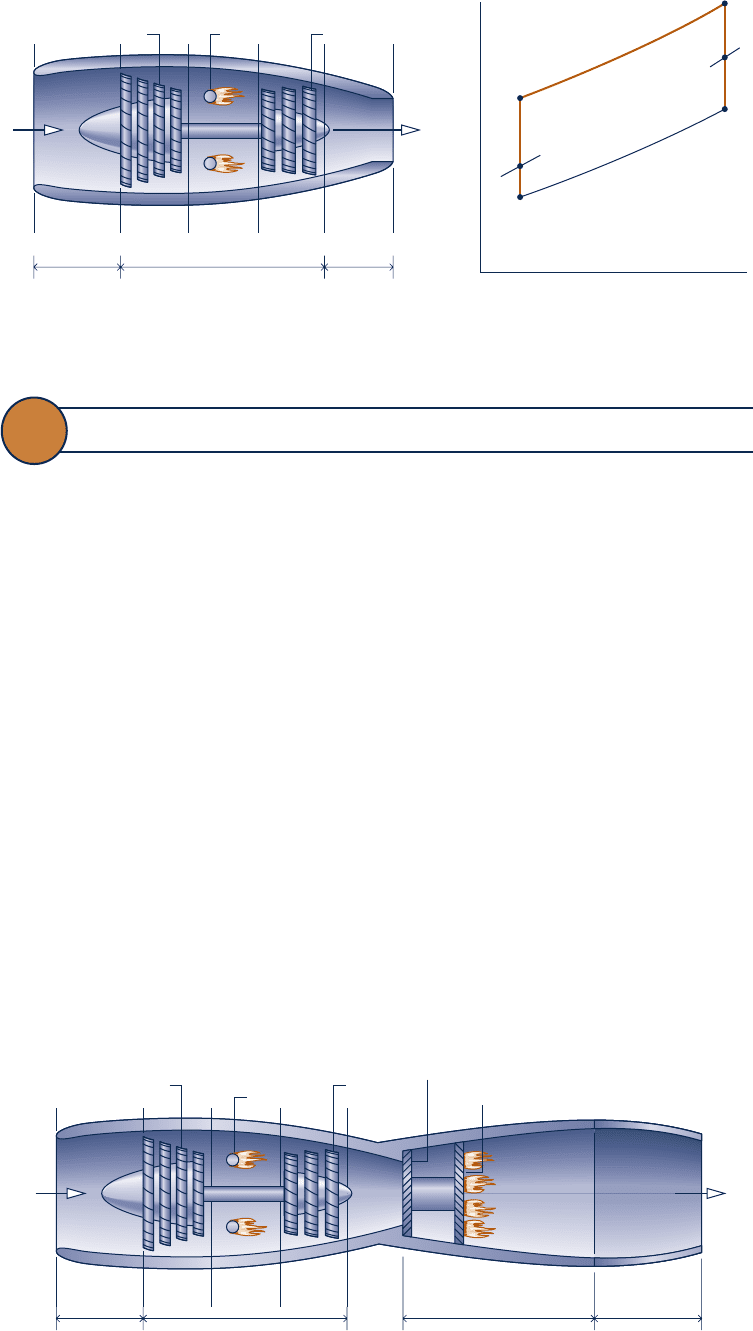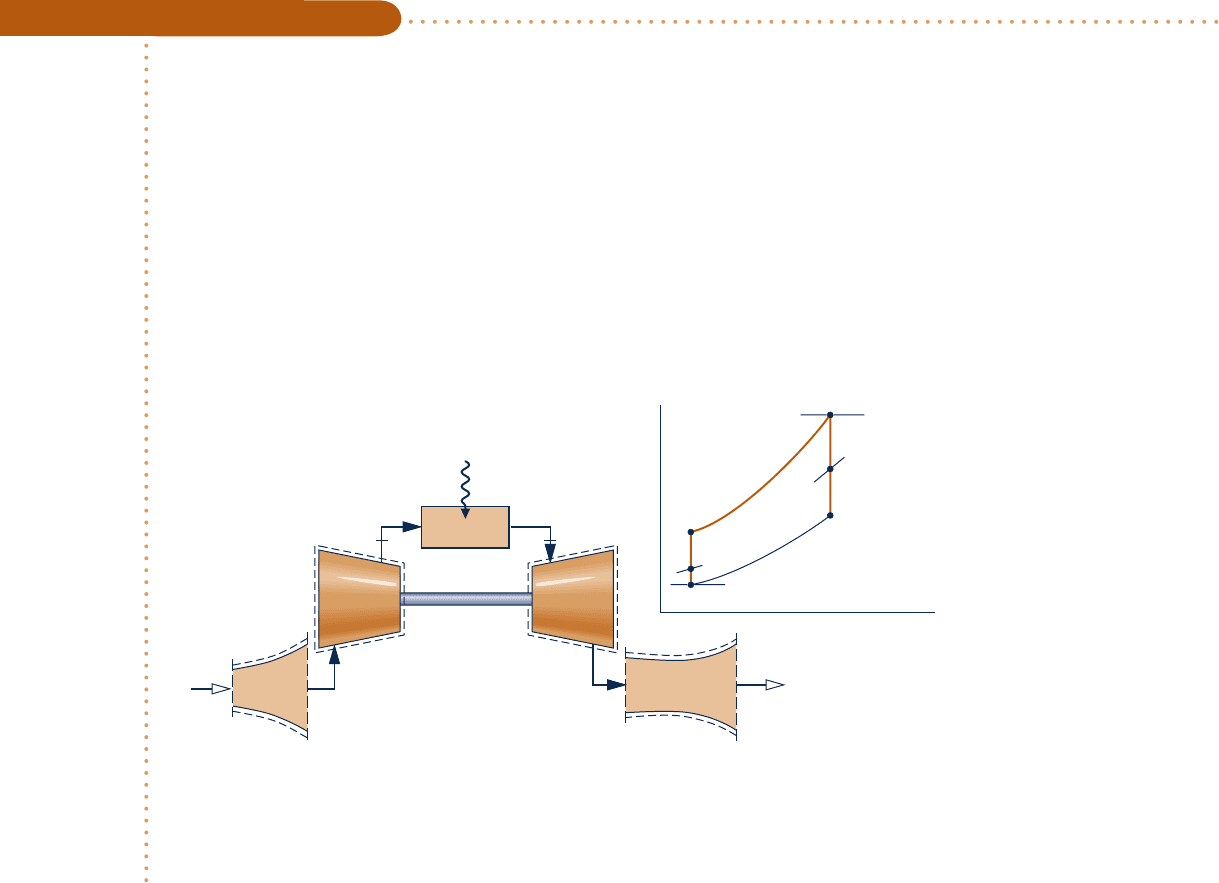Moran M.J., Shapiro H.N. Fundamentals of Engineering Thermodynamics
Подождите немного. Документ загружается.


➌ The results are summarized by the following exergy rate balance sheet in terms of exergy magnitudes on a
rate basis:
Determine the net rate energy is carried out of the plant as water
passes through the condenser, in MW, and comment. Ans. 30.12 MW. The
significance of this energy loss is far less than indicated by the answer. In
terms of exergy, the loss at the condenser is 1.41 MW [see part (b)], which
better measures the limited utility of the relatively low-temperature water
flowing through the condenser.
Net exergy increase of the gas passing
through the combustor: 59.48 MW 100% (70%)*
Disposition of the exergy:
• Net power developed
gas turbine cycle 29.03 MW 48.8% (34.2%)
vapor cycle 15.97 MW 26.8% (18.8%)
Subtotal 45.00 MW 75.6% (53.0%)
• Net exergy lost
with exhaust gas at state 5 1.39 MW 2.3% (1.6%)
from water passing through condenser 1.41 MW 2.4% (1.7%)
• Exergy destruction
air turbine 3.42 MW 5.7% (4.0%)
compressor 2.83 MW 4.8% (3.4%)
steam turbine 1.71 MW 2.9% (2.0%)
pump 0.02 MW — —
heat-recovery steam generator 3.68 MW 6.2% (4.3%)
*Estimation based on fuel exergy. For discussion, see note 3.
The subtotals given in the table under the net power developed heading indicate that the combined cycle is
effective in generating power from the exergy supplied. The table also indicates the relative significance of the
exergy destructions in the turbines, compressor, pump, and heat-recovery steam generator, as well as the relative
significance of the exergy losses. Finally, the table indicates that the total of the exergy destructions overshadows
the losses. While the energy analysis of part (a) yields valuable results about combined-cycle performance, the
exergy analysis of part (b) provides insights about the effects of irreversibilities and true magnitudes of the losses
that cannot be obtained using just energy.
➊ For comparison, note that the combined-cycle thermal efficiency in this case is much greater than those of
the stand-alone regenerative vapor and gas cycles considered in Examples 8.5 and 9.11, respectively.
➋ The development of the appropriate expressions for the rates of entropy production in the turbines, compressor,
pump, and heat-recovery steam generator is left as an exercise.
➌ In this exergy balance sheet, the percentages shown in parentheses are estimates based on the fuel exergy. Although
combustion is the most significant source of irreversibility, the exergy destruction due to combustion cannot be
evaluated using an air-standard analysis. Calculations of exergy destruction
due to combustion (Chap. 13) reveal that approximately 30% of the exergy
entering the combustor with the fuel would be destroyed, leaving about 70%
of the fuel exergy for subsequent use. Accordingly, the value 59.48 MW for
the net exergy increase of the air passing through the combustor is assumed
to be 70% of the fuel exergy supplied. All other percentages in parentheses
are obtained by multiplying the corresponding percentages, based on the
exergy increase of the air passing through the combustor, by the factor 0.7.
Since they account for combustion irreversibility, the table values in paren-
theses give the more accurate picture of combined cycle performance.
Ability to…
❑
apply mass and energy
balances.
❑
determine thermal efficiency.
❑
evaluate exergy quantities.
❑
develop an exergy accounting.
✓
Skills Developed
9.9 Gas Turbine–Based Combined Cycles 543
c09GasPowerSystems.indd Page 543 7/19/10 9:51:19 AM users-133 c09GasPowerSystems.indd Page 543 7/19/10 9:51:19 AM users-133 /Users/users-133/Desktop/Ramakant_04.05.09/WB00113_R1:JWCL170/New/Users/users-133/Desktop/Ramakant_04.05.09/WB00113_R1:JWCL170/New

544 Chapter 9
Gas Power Systems
9.9.2
Cogeneration
Cogeneration systems are integrated systems that yield two valuable products simul-
taneously from a single fuel input, electricity and steam (or hot water), achieving cost
savings. Cogeneration systems have numerous industrial and commercial applications.
District heating is one of these.
District heating plants are located within communities to provide steam or hot water
for space heating and other needs together with electricity for domestic, commercial,
and industrial use. Vapor cycle–based district heating plants are considered in Sec. 8.5.
Building on the combined gas turbine–vapor power cycle introduced in Sec. 9.9.1,
Fig. 9.23 illustrates a district heating system consisting of a gas turbine cycle partnered
with a vapor power cycle operating in the back-pressure mode discussed in Sec. 8.5.3.
In this embodiment, steam (or hot water) is provided from the condenser to service
the district heating load.
Referring again to Fig. 9.23, if the condenser is omitted, steam is supplied directly
from the steam turbine to service the district heating load; condensate is returned to
the heat-recovery steam generator. If the steam turbine is also omitted, steam passes
directly from the heat-recovery unit to the community and back again; power is gen-
erated by the gas turbine alone.
9.10
Integrated Gasification Combined-
Cycle Power Plants
For decades vapor power plants fueled by coal have been the workhorses of U.S.
electricity generation (see Chap. 8). However, human-health and environmental-
impact issues linked to coal combustion have placed this type of power generation under
a cloud. In light of our large coal reserves and the critical importance of electricity
to our society, major governmental and private-sector efforts are aimed at developing
Fig. 9.23
Combined-cycle district heating plant.
Combustor
TurbineCompressor
Q
·
in
W
·
gas
W
·
vap
Vapor
cycle
Heat-recovery
steam generator
Condenser
Gas turbine
Air inlet
Exhaust
Pump
Turbine
Steam
Condensate
c09GasPowerSystems.indd Page 544 7/19/10 9:51:20 AM users-133 c09GasPowerSystems.indd Page 544 7/19/10 9:51:20 AM users-133 /Users/users-133/Desktop/Ramakant_04.05.09/WB00113_R1:JWCL170/New/Users/users-133/Desktop/Ramakant_04.05.09/WB00113_R1:JWCL170/New

alternative power generation technologies using coal, but with fewer adverse effects.
In this section, we consider one such technology: integrated gasification combined-
cycle (IGCC) power plants.
An IGCC power plant integrates a coal gasifier with a combined gas turbine–
vapor power plant like that considered in Sec. 9.9. Key elements of an IGCC plant
are shown in Fig. 9.24. Gasification is achieved through controlled combustion of
coal with oxygen in the presence of steam to produce syngas (synthesis gas) and
solid waste. Oxygen is provided to the gasifier by the companion air separation unit.
Syngas exiting the gasifier is mainly composed of carbon monoxide and hydrogen.
The syngas is cleaned of pollutants and then fired in the gas turbine combustor. The
performance of the combined cycle follows the discussion provided in Sec. 9.9.
In IGCC plants, pollutants (sulfur compounds, mercury, and particulates) are removed
before combustion when it is more effective to do so, rather than after combustion as
in conventional coal-fueled power plants. While IGCC plants emit fewer sulfur dioxide,
nitric oxide, mercury, and particulate emissions than comparable conventional coal
plants, abundant solid waste is still produced that must be responsibly managed.
Taking a closer look at Fig. 9.24, better IGCC plant performance can be realized
through tighter integration between the air-separation unit and combined cycle. For
instance, by providing compressed air from the gas turbine compressor to the air-
separation unit, the compressor feeding ambient air to the air-separation unit can be
eliminated or reduced in size. Also, by injecting nitrogen produced by the separation
unit into the air stream entering the combustor, mass flow rate through the turbine
increases and therefore greater power is developed.
Only a few IGCC plants have been constructed worldwide thus far. Accordingly, only
time will tell if this technology will make significant inroads against coal-fired vapor
power plants, including the newest generation of supercritical plants. Proponents point
to increased combined cycle thermal efficiency as a way to extend the viability of U.S.
coal reserves. Others say investment might be better directed to technologies fostering
9.10 Integrated Gasification Combined-Cycle Power Plants 545
Fig. 9.24 Integrated gasification combined-cycle power plant.
Combustor
Syngas cleanup
Syngas
Air separation unit
TurbineCompressor
Compressor
W
·
gas
W
·
vap
Vapor
cycle
Heat-recovery
steam generator
Condenser
Gas turbine
Air inlet
Air
Exhaust
Pump
Turbine
Cooling
water
Coal
Solid
waste
Makeup water
Mercury
Particulate
removal
Gasifier
Sulfur
O
2
N
2
c09GasPowerSystems.indd Page 545 7/19/10 9:51:23 AM users-133 c09GasPowerSystems.indd Page 545 7/19/10 9:51:23 AM users-133 /Users/users-133/Desktop/Ramakant_04.05.09/WB00113_R1:JWCL170/New/Users/users-133/Desktop/Ramakant_04.05.09/WB00113_R1:JWCL170/New

546 Chapter 9 Gas Power Systems
use of renewable sources of energy for power generation than to technologies fostering
use of coal, which has so many adverse effects related to its utilization.
9.11
Gas Turbines for Aircraft Propulsion
Gas turbines are particularly suited for aircraft propulsion because of their favorable
power-to-weight ratios. The turbojet engine is commonly used for this purpose. As
illustrated in Fig. 9.25a, this type of engine consists of three main sections: the diffuser,
the gas generator, and the nozzle.
The diffuser placed before the compressor decelerates the incoming air relative to
the engine. A pressure rise known as the ram effect is associated with this deceleration.
The gas generator section consists of a compressor, combustor, and turbine, with the
same functions as the corresponding components of a stationary gas turbine power
plant. In a turbojet engine, the turbine power output need only be sufficient to drive
the compressor and auxiliary equipment, however.
Combustion gases leave the turbine at a pressure significantly greater than atmo-
spheric and expand through the nozzle to a high velocity before being discharged to
the surroundings. The overall change in the velocity of the gases relative to the engine
gives rise to the propulsive force, or thrust.
Some turbojets are equipped with an afterburner, as shown in Fig. 9.26. This is
essentially a reheat device in which additional fuel is injected into the gas exiting the
turbine and burned, producing a higher temperature at the nozzle inlet than would
be achieved otherwise. As a consequence, a greater nozzle exit velocity is attained,
resulting in increased thrust.
TURBOJET ANALYSIS. The T–s diagram of the processes in an ideal turbojet engine
is shown in Fig. 9.25b. In accordance with the assumptions of an air-standard analysis, the
working fluid is air modeled as an ideal gas. The diffuser, compressor, turbine, and nozzle
processes are isentropic, and the combustor operates at constant pressure.
turbojet engine
ram effect
afterburner
Fig. 9.25 Turbojet engine
schematic and accompanying
ideal T–s diagram.
T
p = c
p = c
s
1
a
2
3
4
5
Compressor
Diffuser NozzleGas generator
(a)(b)
Combustors Turbine
Product
gases out
Air
in
a1234
5
Fig. 9.26 Schematic of a
turbojet engine with
afterburner.
Compressor
Diffuser Gas generator Afterburner duct Adjustable
nozzle
Combustors
Turbine
Fuel-spray bars
Air
in
Flame holder
Product
gases out
c09GasPowerSystems.indd Page 546 7/19/10 9:51:26 AM users-133 c09GasPowerSystems.indd Page 546 7/19/10 9:51:26 AM users-133 /Users/users-133/Desktop/Ramakant_04.05.09/WB00113_R1:JWCL170/New/Users/users-133/Desktop/Ramakant_04.05.09/WB00113_R1:JWCL170/New

c Process a–1 shows the pressure rise that occurs in the diffuser as the air decelerates
isentropically through this component.
c Process 1–2 is an isentropic compression.
c Process 2–3 is a constant-pressure heat addition.
c Process 3–4 is an isentropic expansion through the turbine during which work is
developed.
c Process 4–5 is an isentropic expansion through the nozzle in which the air acceler-
ates and the pressure decreases.
Owing to irreversibilities in an actual engine, there would be increases in specific
entropy across the diffuser, compressor, turbine, and nozzle. In addition, there would
be a combustion irreversibility and a pressure drop through the combustor of the
actual engine. Further details regarding flow through nozzles and diffusers are pro-
vided in Secs. 9.13 and 9.14. The subject of combustion is discussed in Chap. 13.
In a typical thermodynamic analysis of a turbojet on an air-standard basis, the
following quantities might be known: the velocity at the diffuser inlet, the compressor
pressure ratio, and the turbine inlet temperature. The objective of the analysis might
then be to determine the velocity at the nozzle exit. Once the nozzle exit velocity is
known, the thrust can be determined by applying Newton’s second law of motion in
a form suitable for a control volume (Sec. 9.12). All principles required for the ther-
modynamic analysis of turbojet engines on an air-standard basis have been intro-
duced. Example 9.13 provides an illustration.
9.11 Gas Turbines for Aircraft Propulsion 547
Analyzing a Turbojet Engine
c c c c EXAMPLE 9.13 c
Air enters a turbojet engine at 11.8 lbf/in.
2
, 4308R, and an inlet velocity of 620 miles/h (909.3 ft/s). The pressure
ratio across the compressor is 8. The turbine inlet temperature is 21508R and the pressure at the nozzle exit is
11.8 lbf/in.
2
The work developed by the turbine equals the compressor work input. The diffuser, compressor,
turbine, and nozzle processes are isentropic, and there is no pressure drop for flow through the combustor. For
operation at steady state, determine the velocity at the nozzle exit and the pressure at each principal state.
Neglect kinetic energy except at the inlet and exit of the engine, and neglect potential energy throughout.
SOLUTION
Known:
An ideal turbojet engine operates at steady state. Key operating conditions are specified.
Find: Determine the velocity at the nozzle exit, in ft/s, and the pressure, in lbf/in.
2
, at each principal state.
Schematic and Given Data:
Fig. E9.13
4
1
23
2
1
3
4
5
5
T
a
= 430°R
p
a
= 11.8 lbf/in.
2
V
a
= 620 mi/hr
p
5
= 11.8 lbf/in.
2
T
3
= 2150°R
T
3
= 2150°R
T
a
= 430°R
T
s
V
1
= 0
a
a
TurbineCompressor
Diffuser
Nozzle
Combustor
p
2/
p
1
= 8
Q
·
in
c09GasPowerSystems.indd Page 547 7/19/10 9:51:31 AM users-133 c09GasPowerSystems.indd Page 547 7/19/10 9:51:31 AM users-133 /Users/users-133/Desktop/Ramakant_04.05.09/WB00113_R1:JWCL170/New/Users/users-133/Desktop/Ramakant_04.05.09/WB00113_R1:JWCL170/New

548 Chapter 9
Gas Power Systems
Engineering Model:
1.
Each component is analyzed as a control volume at steady state. The control volumes are shown on the
accompanying sketch by dashed lines.
2. The diffuser, compressor, turbine, and nozzle processes are isentropic.
3. There is no pressure drop for flow through the combustor.
4. The turbine work output equals the work required to drive the compressor.
5. Except at the inlet and exit of the engine, kinetic energy effects can be ignored. Potential energy effects
are negligible throughout.
6. The working fluid is air modeled as an ideal gas.
Analysis: To determine the velocity at the exit to the nozzle, the mass and energy rate balances for a control
volume enclosing this component reduce at steady state to give
0 5 Q
#
cv
0
2 W
#
cv
0
1 m
#
c1h
4
2 h
5
21 a
V
4
2
0
2 V
2
5
2
b1 g1z
4
2
0
z
5
2d
where m
#
is the mass flow rate. The inlet kinetic energy is dropped by assumption 5. Solving for V
5
V
5
5 221h
4
2 h
5
2
This expression requires values for the specific enthalpies h
4
and h
5
at the nozzle inlet and exit, respectively. With
the operating parameters specified, the determination of these enthalpy values is accomplished by analyzing each
component in turn, beginning with the diffuser. The pressure at each principal state can be evaluated as a part
of the analyses required to find the enthalpies h
4
and h
5
.
Mass and energy rate balances for a control volume enclosing the diffuser reduce to give
h
1
5 h
a
1
V
2
a
2
With h
a
from Table A-22E and the given value of V
a
➊
h
1
5 102.7 Btu
/
lb 1 c
1909.32
2
2
da
ft
2
s
2
b`
1 lbf
32.2 lb ? ft
/
s
2
``
1 Btu
778 ft ? lbf
`
5 119.2 Btu
/
lb
Interpolating in Table A-22E gives p
r1
5 1.051. The flow through the diffuser is isentropic, so pressure p
1
is
p
1
5
p
r1
p
ra
p
a
With p
r
data from Table A-22E and the known value of p
a
p
1
5
1.051
0.6268
111.8 lbf
/
in.
2
25 19.79 lbf
/
in.
2
Using the given compressor pressure ratio, the pressure at state 2 is p
2
5 8(19.79 lbf/in.
2
) 5 158.3 lbf/in.
2
The flow through the compressor is also isentropic. Thus
p
r2
5 p
r1
p
2
p
1
5 1.0511825 8.408
Interpolating in Table A-22E, we get h
2
5 216.2 Btu/lb.
At state 3 the temperature is given as T
3
5 21508R. From Table A-22E, h
3
5 546.54 Btu/lb. By assump-
tion 3, p
3
5 p
2
. The work developed by the turbine is just sufficient to drive the compressor (assumption 4).
That is
W
#
t
m
#
5
W
#
c
m
#
c09GasPowerSystems.indd Page 548 7/19/10 9:51:33 AM users-133 c09GasPowerSystems.indd Page 548 7/19/10 9:51:33 AM users-133 /Users/users-133/Desktop/Ramakant_04.05.09/WB00113_R1:JWCL170/New/Users/users-133/Desktop/Ramakant_04.05.09/WB00113_R1:JWCL170/New

OTHER APPLICATIONS. Other related applications of the gas turbine
include turboprop and turbofan engines. The turboprop engine shown in Fig. 9.27a
consists of a gas turbine in which the gases are allowed to expand through the
turbine to atmospheric pressure. The net power developed is directed to a propel-
ler, which provides thrust to the aircraft. Turboprops are able to achieve speeds
up to about 850 km/h (530 miles/h). In the turbofan shown in Fig. 9.27b, the core
of the engine is much like a turbojet, and some thrust is obtained from expansion
or
h
3
2 h
4
5 h
2
2 h
1
Solving for h
4
h
4
5 h
3
1 h
1
2 h
2
5 546.54 1 119.2 2 216.2
5 449.5 Btu
/
lb
Interpolating in Table A-22E with h
4
gives p
r4
5 113.8.
The expansion through the turbine is isentropic, so
p
4
5 p
3
p
r4
p
r3
With p
3
5 p
2
and p
r
data from Table A-22E
p
4
5 1158.3 lbf
/
in.
2
2
113.8
233.5
5 77.2 lbf
/
in.
2
The expansion through the nozzle is isentropic to p
5
5 11.8 lbf/in.
2
Thus
p
r5
5 p
r4
p
5
p
4
5 1113.82
11.8
77.2
5 17.39
From Table A-22E, h
5
5 265.8 Btu/lb, which is the remaining specific enthalpy
value required to determine the velocity at the nozzle exit.
Using the values for h
4
and h
5
determined above, the velocity at the nozzle
exit is
V
5
5
1
21h
4
2 h
5
2
5
B
21449.5 2 265.82
Btu
lb
`
32.2 lb ? ft
/
s
2
1 lbf
``
778 ft ? lbf
1 Btu
`
5 3034 ft
/
s 12069 mi
/
h2
➊ Note the unit conversions required here and in the calculation of V
5
.
➋ The increase in the velocity of the air as it passes through the engine gives
rise to the thrust produced by the engine. A detailed analysis of the forces
acting on the engine requires Newton’s second law of motion in a form suit-
able for control volumes (see Sec. 9.12.1).
Using Eq. 6.47, the isentropic nozzle efficiency, what is the
nozzle exit velocity, in ft/s, if the efficiency is 90%? Ans. 2878 ft/s.
➋
Ability to…
❑
sketch the schematic of the
turbojet engine and the T–s
diagram for the correspond-
ing air-standard cycle.
❑
evaluate temperatures and
pressures at each principal
state and retrieve necessary
property data.
❑
apply mass, energy, and
entropy principles.
❑
calculate the nozzle exit
velocity.
✓
Skills Developed
9.11 Gas Turbines for Aircraft Propulsion 549
c09GasPowerSystems.indd Page 549 7/19/10 9:51:35 AM users-133 c09GasPowerSystems.indd Page 549 7/19/10 9:51:35 AM users-133 /Users/users-133/Desktop/Ramakant_04.05.09/WB00113_R1:JWCL170/New/Users/users-133/Desktop/Ramakant_04.05.09/WB00113_R1:JWCL170/New

550 Chapter 9 Gas Power Systems
through the nozzle. However, a set of large-diameter blades attached to the front
of the engine accelerates air around the core. This bypass flow provides additional
thrust for takeoff, whereas the core of the engine provides the primary thrust for
cruising. Turbofan engines are commonly used for commercial aircraft with flight
speeds of up to about 1000 km/h (600 miles/h). A particularly simple type of
engine known as a ramjet is shown in Fig. 9.27c. This engine requires neither a
compressor nor a turbine. A sufficient pressure rise is obtained by decelerating
the high-speed incoming air in the diffuser (ram effect). For the ramjet to operate,
therefore, the aircraft must already be in flight at high speed. The combustion
products exiting the combustor are expanded through the nozzle to produce the
thrust.
In each of the engines mentioned thus far, combustion of the fuel is supported by
air brought into the engines from the atmosphere. For very high-altitude flight and
space travel, where this is no longer possible, rockets may be employed. In these
applications, both fuel and an oxidizer (such as liquid oxygen) are carried on board
the craft. Thrust is developed when the high-pressure gases obtained on combustion
are expanded through a nozzle and discharged from the rocket.
Considering Compressible
Flow Through Nozzles
and Diffusers
In many applications of engineering interest, gases move at relatively high veloc-
ities and exhibit appreciable changes in specific volume (density). The flows
through the nozzles and diffusers of jet engines discussed in Sec. 9.11 are impor-
tant examples. Other examples are the flows through wind tunnels, shock tubes,
and steam ejectors. These flows are known as compressible flows. In this part of
the chapter, we introduce some of the principles involved in analyzing compress-
ible flows.
compressible flow
Fig. 9.27 Other examples of aircraft engines. (a) Turboprop. (b) Turbofan. (c) Ramjet.
(a)(b)
(c)
Propeller
Fan
By-pass flow
Basic engine-core
Diffuser
Flame holder
Nozzle
c09GasPowerSystems.indd Page 550 7/19/10 9:51:37 AM users-133 c09GasPowerSystems.indd Page 550 7/19/10 9:51:37 AM users-133 /Users/users-133/Desktop/Ramakant_04.05.09/WB00113_R1:JWCL170/New/Users/users-133/Desktop/Ramakant_04.05.09/WB00113_R1:JWCL170/New

9.12 Compressible Flow Preliminaries
Concepts introduced in this section play important roles in the study of compressible
flows. The momentum equation is introduced in a form applicable to the analysis of
control volumes at steady state. The velocity of sound is also defined, and the concepts
of Mach number and stagnation state are discussed.
9.12.1
Momentum Equation for Steady One-Dimensional Flow
The analysis of compressible flows requires the principles of conservation of mass
and energy, the second law of thermodynamics, and relations among the thermody-
namic properties of the flowing gas. In addition, Newton’s second law of motion is
required. Application of Newton’s second law of motion to systems of fixed mass
(closed systems) involves the familiar form
F
5
ma
where F is the resultant force acting on a system of mass m and a is the acceleration.
The object of the present discussion is to introduce Newton’s second law of motion
in a form appropriate for the study of the control volumes considered in subsequent
discussions.
Consider the control volume shown in Fig. 9.28, which has a single inlet, designated
by 1, and a single exit, designated by 2. The flow is assumed to be one-dimensional
at these locations. The energy and entropy rate equations for such a control volume
have terms that account for energy and entropy transfers, respectively, at the inlets
and exits. Momentum also can be carried into or out of the control volume at the
inlets and exits, and such transfers can be accounted for as
≥
time rate of momentum
transfer into or
out of a control volume
accompan
y
in
g
mass flow
¥5 m
#
V
(9.30)
In this expression, the momentum per unit of mass flowing across the boundary of
the control volume is given by the velocity vector V. In accordance with the one-
dimensional flow model, the vector is normal to the inlet or exit and oriented in the
direction of flow.
In words, Newton’s second law of motion for control volumes is
£
time rate of change
of momentum contained
within the control volume
§
5
£
resultant force
acting on the
control volume
§
1 £
net rate at which momentum is
transferred into the control
volume accompan
y
in
g
mass flow
§
9.12 Compressible Flow Preliminaries 551
Fig. 9.28 One-inlet, one-exit
control volume at steady state
labeled with momentum transfers
accompanying mass flow.
2
No flow through this
portion of the boundary
1
z
x
y
m
·
V
2
m
·
V
1
c09GasPowerSystems.indd Page 551 7/19/10 10:27:46 AM users-133 c09GasPowerSystems.indd Page 551 7/19/10 10:27:46 AM users-133 /Users/users-133/Desktop/Ramakant_04.05.09/WB00113_R1:JWCL170/New/Users/users-133/Desktop/Ramakant_04.05.09/WB00113_R1:JWCL170/New

552 Chapter 9
Gas Power Systems
steady-state
momentum equation
At steady state, the total amount of momentum contained in the control volume is
constant with time. Accordingly, when applying Newton’s second law of motion to
control volumes at steady state, it is necessary to consider only the momentum accom-
panying the incoming and outgoing streams of matter and the forces acting on the
control volume. Newton’s law then states that the resultant force F acting on the
control volume equals the difference between the rates of momentum exiting and
entering the control volume accompanying mass flow. This is expressed by the fol-
lowing steady-state form of the momentum equation
F 5 m
#
2
V
2
2 m
#
1
V
1
5 m
#
1
V
2
2 V
1
2
(9.31)
Since m
#
1
5 m
#
2
at steady state, the common mass flow is designated in this expression
simply as m
#
. The expression of Newton’s second law of motion given by Eq. 9.31
suffices for subsequent discussions. More general control volume formulations are
normally provided in fluid mechanics texts.
9.12.2
Velocity of Sound and Mach Number
A sound wave is a small pressure disturbance that propagates through a gas, liquid,
or solid at a velocity c that depends on the properties of the medium. In this section
we obtain an expression that relates the velocity of sound, or sonic velocity, to other
properties. The velocity of sound is an important property in the study of compress-
ible flows.
MODELING PRESSURE WAVES. Let us begin by referring to Fig. 9.29a, which
shows a pressure wave moving to the right with a velocity of magnitude c. The wave
is generated by a small displacement of the piston. As shown on the figure, the pres-
sure, density, and temperature in the region to the left of the wave depart from the
respective values of the undisturbed fluid to the right of the wave, which are desig-
nated simply p, r, and T. After the wave has passed, the fluid to its left is in steady
motion with a velocity of magnitude DV.
Figure 9.29a shows the wave from the point of view of a stationary observer. It is
easier to analyze this situation from the point of view of an observer at rest relative
to the wave, as shown in Fig. 9.29b. By adopting this viewpoint, a steady-state analysis
can be applied to the control volume identified on the figure. To an observer at rest
relative to the wave, it appears as though the fluid is moving toward the stationary
wave from the right with velocity c, pressure p, density r, and temperature T and
TAKE NOTE...
The resultant force F
includes the forces due to
pressure acting at the inlet
and exit, forces acting on
the portion of the boundary
through which there is no
mass flow, and the force of
gravity.
Fig. 9.29 Illustrations used to analyze the propagation of a sound wave. (a) Propagation of a
pressure wave through a quiescent fluid relative to a stationary observer. (b) Observer at rest
relative to the wave.
p, T, ρ
(a)(b)
p, ρ, T
ΔV
p + Δp
ρ + Δρ
T + ΔT
c – ΔV
p + Δp
ρ + Δρ
T + ΔT
c
c
V = 0
Piston
Stationary
observer
Control volume for an
observer moving with
the wave
Observer on
wave
21
Undisturbed fluid
c09GasPowerSystems.indd Page 552 7/19/10 10:27:50 AM users-133 c09GasPowerSystems.indd Page 552 7/19/10 10:27:50 AM users-133 /Users/users-133/Desktop/Ramakant_04.05.09/WB00113_R1:JWCL170/New/Users/users-133/Desktop/Ramakant_04.05.09/WB00113_R1:JWCL170/New
